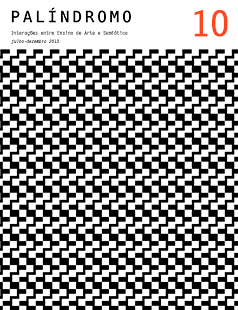La Formación Superior en Artes Mediatiazada por Dispositivos Hipermediales Dinámicos
DOI:
https://doi.org/10.5965/2175234605102013067Parole chiave:
formação superior em artes, perspectiva semiótica, dispositivo hipermedial dinâmicoAbstract
O presente artigo aborda aspectos da formação superior em artes utilizando Tecnologias da Informação e da Comunicação (TIC) desde uma perspectiva semiótica. Baseia-se no referencial teórico-metodológico dos Dispositivos Hipermediais Dinâmicos (DHD) no entendimento de que a complexidade dos fenômenos em questão demanda de uma visão complexa e interdisciplinar para dar conta das múltiplas dimensões que os compõem. Após conceitualizar a noção de DHD e suas bases semióticas, apresenta-se um caso desenvolvido no âmbito de uma universidade pública da Argentina onde se realizou, no contexto de um projeto de pesquisa, uma experiência de formação superior em artes a partir da configuração de um DHD contextualizado em atenção à especificidade disciplinar. Finalmente, conclui-se que a abordagem adoptada resulta consistente para a conceitualização de problemáticas de mediatização educativa no âmbito do atual contexto físico- virtual.
Downloads
Riferimenti bibliografici
BUJÁN, F. Interpenetración sistémica y procesos educativos. Semeiosis: Semiótica e Transdiciplinaridade em Revista, São Paulo, Nº 2, ECA-USP, maio de 2011. Disponível em: http://www.semeiosis.com.br/interpenetracion-sistemica-y-procesos-educativos/. Acesso em: set. 2013.
CULIOLI, A. Escritos. Buenos Aires: Santiago Arcos, 2010.
DEY, A.K.; SALBER, D.; ABOWD, G. A Conceptual Framework and a Toolkit for Supporting the Rapid Prototyping of Context-Aware Applications, anchor article of a special issue on Context-Aware Computing. Human-Computer Interaction (HCI) Journal, Vol. 16 (2- 4), 2001.
GUARNIERI, G. El modo interactivo del Dispositivo Hipermedial Dinámico (Tesis doctoral). Facultad de Humanidades y Artes, Universidad Nacional de Rosario (UNR), 2011.
LITWIN, E. Las configuraciones didácticas. Una nueva agenda para la enseñanza superior. Buenos Aires: Paidós, 1997.
LUHMANN, N. Sistemas Sociales: lineamientos para una teoría general. Barcelona: Anthropos, 1998.
MAINGUENEAU, D. Análisis de textos de comunicación. Buenos Aires: Nueva Visión, 2009.
PERAYA, D. Médiation et médiatisation: le campus virtual. Revue Hermès, Nº 25, Paris: CNRS Éditions, p. 153-167, 1999.
SAN MARTÍN, P. Hipertexto. Seis propuestas para este milenio, Buenos Aires: La Crujía, 2003.
SAN MARTÍN, P. Hacia un dispositivo hipermedial dinámico. Educación e investigación para el campo audiovisual interactivo. Buenos Aires: Universidad Nacional de Quilmes (UNQUI), 2008.
SAN MARTÍN, P. et al El Dispositivo Hipermedial Dinámico Campus Virtual UNR. Secretaría de Tecnologías Educativas y Gestión, Universidad Nacional de Rosario (UNR), 2010.
SAN MARTÍN, P.; TRAVERSA, O. (Comp.) El Dispositivo Hipermedial Dinámico Pantallas Críticas. Buenos Aires: Santiago Arcos, 2011.
TRAVERSA, O. Aproximaciones a la noción de dispositivo, Signo y Seña, Nº 12, Buenos Aires, Revista del Instituto de Lingüística, Universidad de Buenos Aires (UBA), p. 233-247, abril de 2001.
TRAVERSA, O. Dispositivo-Enunciación: en torno a sus modos de articularse. In: SAN MARTÍN, P. y TRAVERSA, O. El Dispositivo Hipermedial Dinámico Pantallas Críticas. Buenos Aires: Santiago Arcos, 2011, Cap. 1, p. 17-29.
VERÓN, E. La semiosis social: fragmentos de una teoría de la discursividad. Barcelona:Gedisa, 1987.
VERÓN, E. Fragmentos de un tejido. Barcelona: Gedisa, 2004.
VERÓN, E. Du sujet aux acteurs. La sémiotique ouverte aux interfaces. In: BOUTAUD, J-J; VERÓN, E. Sémiotique Ouverte. Itinéraires sémiotiques en communication. Paris: Lavoisier, Hermès Science, 2007.
VERÓN, E. La semiosis social, 2. Ideas, momentos, interpretantes. Paidós: Buenos Aires, 2013.
Downloads
Pubblicato
Come citare
Fascicolo
Sezione
Licenza
Copyright (c) 2014 Federico Buján, Patricia Silvana San Martín

TQuesto lavoro è fornito con la licenza Creative Commons Attribuzione 4.0 Internazionale.
DECLARAÇÃO DE DIREITOS AUTORAIS
a. Os artigos publicados pela revista são de uso gratuito, destinados a aplicações acadêmicas e não comerciais. Todos os direitos autorais são atribuídos à revista. Os artigos cujos autores são identificados representam a expressão do ponto de vista de seus autores e não a posição oficial da Revista Palíndromo. O (s) autor (es) compromete-se sempre que publicar material referente ao artigo publicado no Palíndromo mencionar esta publicação da seguinte forma:
Este artigo foi publicado originalmente pela revista Palíndromo em seu volume (coloque o volume), número (coloque o número) no ano de (coloque o ano) e pode ser acessado em: http://www.revistas.udesc.br/index.php/palindromo
b. Plágio, em todas as suas formas, constitui um comportamento antiético de publicação e é inaceitável. A revista Palíndromo utiliza o software iThenticate de controle de similaridade


